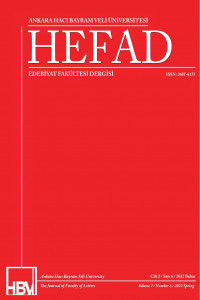ERKEKLERİN DÜNYASINDA KADIN OLMAK: ANNE SEXTON’IN İKON KIRICILIĞA DAİR MANİFESTOSU
ataerkillik, kadın, başkaldırı, cadı, Anne Sexton
TO BE A WOMAN IN MEN’S WORLD: ANNE SEXTON’S MANIFESTO OF ICONOCLASM
patriarchy, woman, rebellion, witch, Anne Sexton,
___
- ANAPOL, D. (2010). Polyamory in the Twenty-First Century: Love and Intimacy with Multiple Partners. New York: Rowman & Littlefield Publishers, Inc.
- ÇELIK, Y. (2018). 20. Yüzyıl Amerikan Şiirinde Arayış Şairleri: 12 Kadın Şair ve 12 Şiir. Ankara: Kurgan Edebiyat.
- ÇELIK, Y. (2019). “Cennetteki Kadından ‘Evdeki Melek’e: Ataerkil Bir Toplumda İdeal Kadın Yaratmanın/Eğitmenin Şifreleri”. Er, A. & Çelik, Y. (ed.). Edebiyatta Kadın ve Eğitim. Ankara: Bilgin Kültür Sanat Yayınları.
- GILL, J. (2004). “Anne sexton and Confessional Poetics”. The Review of English studies, New Series, Vol. 55, No. 220, June, 425-445.
- GILL, R. (1995). Mastering English Literature. 2nd Edition. London: Macmillan Press Ltd.
- GRAY SEXTON, L. (1977). Anne Sexton: A Self-Portrait Through Letters. Boston: Houghton Mifflin.
- HALL, C. (1989). Anne Sexton. Boston: G.K. Hall.
- HOLY BIBLE, https://www.bible.com/bible/111/GEN.2.NIV
- HOOK, B. (2000). Feminism is for Everybody: Passionate Politics. Cambridge: South End Press. KURUP, P. K. J. (1991). Contemporary Indian Poetry in English. Delhi: Atlantic Publishers.
- LAL, P. (ed.). (1969). Introduction to Modern Indian Poetry in English. Calcutta: Writers’ Workshop, x-xii.
- LERNER, G. (1986). The Creation of Patriarchy. Oxford: Oxford University Press.
- Madej-Stang, A. (2015). Which Face of Witch: Self-Representations of Women as Witches in Works of Contemporary British Women Writers. Cambridge: Cambridge Scholars Publishing.
- MARX, P. (1966). “Interview with Anne Sexton”. The Hudson Review, Vol. 18, No. 4, 560-570.
- MIDDLEBROOK, D. W. (2000). “On Her Kind”. Modern American Poetry, Nelson, C. (ed.). Department of English, University of Illinois at Urbana.
- MITCHELL, J. (2000). Mad Men and Medusas. New York: Basic Books.
- MOORE, H. (1985). “Interview with Anne Sexton”. Colburn, S. E. (ed.). No Evil Star: Selected Essays, Interviews and Prose – Anne Sexton, Michigan. University of Michigan Press.
- NAPIKOSKI, L. (2020). “Patriarchal Society According to Feminism: Feminist Theories of Patriarchy”. https://www.thoughtco.com/patriarchal-society-feminism-definition-3528978
- NATHAN, D., KELKAR, G. & XIAOGANG, Y. (1988). “Women as Witches and Keepers of Demons: Cross-Cultural Analysis of Struggles to Change Gender Relations”. Economic and Political Weekly, 33(44), (October), 50-51.
- NIELSEN, L. (2012). Father-Daughter Relationships: Contemporary Research and Issues. London: Routledge.
- OGDEN, A. S. (1986). The Great American Housewife: From Helpmate to Wage Earner, 1776-1986. Westport: Greenwood Press.
- OLSON, L. M. (2003). “Virginia Woolf’s Cotton Wool of Daily Life”. Journal of Modern Literature, Vol. 26, No. 2, (Winter), 42-65.
- ÖZATA, C. (2021). “Cinderella Complex Created through Male Dominance in Shakespearean Context: The Taming of the Shrew”. Tokat Gaziosmanpaşa Dergisi Sosyal Bilimler Araştırma Dergisi, June, Summer Issue, 49-55.
- RICH, A. (2012). “Anne Sexton: 1928-1974”. American Poetry Review, November/December, 7.
- ROSENTHAL, M. L. (1959). “Poetry as Confession”. The Nation, 189, 154-5.
- SEXTON, A. (1960). To Bedlam and Part Way Back. Boston: Houghton Mifflin Company.
- SEXTON, A. (1962). All My Pretty Ones. Boston: Houghton Mifflin Company.
- SEXTON, A. (2007). The Complete Poems: Anne Sexton. Boston: Houghton Mifflin Company.
- SEXTON, L. G. (1977). Anne Sexton: A Self-Portrait Through Letters. Boston: Houghton Mifflin Company.
- WALBY, S. (1990). Theorizing Patriarchy. Oxford: Basil Blackwell Ltd.
- WEEDON, C. (1987). Feminist Practice and Poststructuralist Theory. Cambridge: Blackwell.
- ISSN: 2687-6175
- Yayın Aralığı: Yılda 2 Sayı
- Başlangıç: 2019
- Yayıncı: Ankara Hacı Bayram Veli Üniversitesi
KÜÇÜK ADAMIN DÖNÜŞ HAYALİ: ORHAN KEMAL’DE UTANÇ VE İNTİKAM
ORTA ANADOLU’DA GEÇ TUNÇ ÇAĞI SONU VE DEMİR ÇAĞI ÜZERİNE BİR DEĞERLENDİRME
ERKEKLERİN DÜNYASINDA KADIN OLMAK: ANNE SEXTON’IN İKON KIRICILIĞA DAİR MANİFESTOSU
SON BULGULAR IŞIĞINDA KURUL KALESİ METAL UZUN MENZİLLİ SİLAHLARI
Süleyman Yücel ŞENYURT, Umut ZOROĞLU
ALAN AYCKBOURN’ÜN TRANSHÜMANİZMİ VE POSTHUMAN DURUMUNU KEŞFİ: HENCEFORWARD (ŞİMDİDEN SONRA)
ÇİN BASININDA “OSMANLI-TÜRKİYE ALGISI” VE DEĞİŞİMİ, 1908-1930
